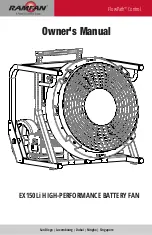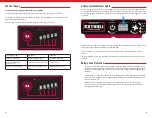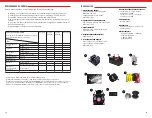
18
19
Battery packs do require routine maintenance and care to maximize their useful life and
maintain warranty coverage. Read and follow the guidelines in this manual to safely use
your lithium-ion battery packs and achieve battery life span.
Lithium-Ion Battery Maintenance Guidelines
According to leading cell manufacturers (LG, Samsung, Panasonic), the estimated life of a
lithium-ion battery is 500 charge cycles. When stating approximate useful life of a battery
in units of “charge cycles,” cell manufacturers define this as the point where the battery
capacity (Ah) is reduced to 80% of original. This means battery is not “dead” after 500
charge cycles, but runtime is significantly reduced, and replacement should be considered.
Partial discharge of lithium-ion batteries is fine. There is no “memory effect” and the battery
does not need periodic full discharge cycles to prolong life.
Overview
Storage
When storing, remove battery packs from fan and store in a dry and cool location. Avoid
extreme temperatures.
• Recommended Storage Temperature: 5
o
C to 20
o
C (41
o
F to 68
o
F)
• Maximum relative humidity during storage: 90% RH
NOTE: all batteries self-discharge during storage. Higher temperature (>20
o
C or 68
o
F) reduce
the battery storage life.
Lithium-ion batteries should be stored in a charged state, ideally around 30% state of
charge (SoC). See “Storage/Transport Mode” section of this manual for easy discharging
steps to follow before storing battery packs.
Long-term (>6 months) storage of battery packs is not recommended. When a battery pack
has been unused for 6 months, check the charge status and either charge or dispose of the
battery as appropriate.
Recommendations
• Battery packs will last significantly longer when run in pairs (two battery packs per fan)
as there is 50% less discharge current per pack.
• As with any equipment, batteries will wear out faster with heavy use. Depth of
Discharge (DoD) determines the cycle count of the battery. The smaller the discharge
(low DoD), the less stress is enacted on the chemistry of the battery and the longer the
battery will ultimately last. Ideally, operators should avoid full discharges and charge
the battery after every use.
Maintenance and Disposal
• DO NOT disassemble the ventilator for maintenance reasons.
• Do not loosen screws on control box without contacting Euramco customer service.
They are torqued to a setting to achieve water tightness.
• Completely unravel power cord and place unit on a flat, stable surface. Clean ventilator
periodically to remove accumulated dust or particles from ventilator guards, impeller
blade and heat sink in rear of controller (ribbed). Use only biodegradable detergents. If
power washing, avoid controller housing especially gaskets and control panel.
• Contact factory for replacement parts and installation instructions. To order spare
parts call Euramco Group
+1.619.670.9590 or [email protected]
• Always dispose of your battery pack according to federal, state and local regulations.
• Even discharged batteries contain some energy. Before disposing of, use electrical tape
to cover the terminals to prevent the battery pack from short circuit.
• Properly dispose of battery packs when necessary. Contact your local hazardous
materials e-waste collection department for details or proper disposal of rechargeable
batteries.













